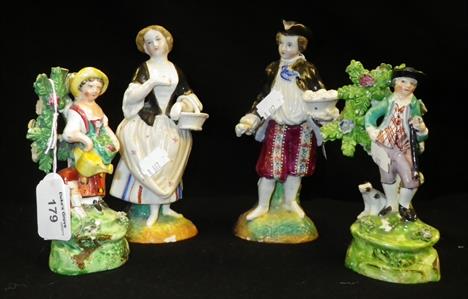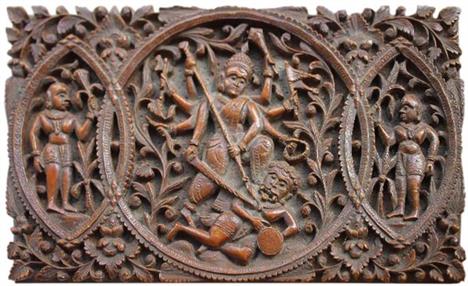We found 659587 price guide item(s) matching your search
There are 659587 lots that match your search criteria. Subscribe now to get instant access to the full price guide service.
Click here to subscribe- List
- Grid
-
659587 item(s)/page
A pair rare of Val d`Osne foundry cast iron term figures of a boy and girl circa 1870 160cm.; 63ins high by 25cm.; 10ins diameter A Herm was originally a representation of the head of Hermes rising from a pedestal. In gardens the word is used loosely to signify any head on a pedestal which is either rectangular or tapers downwards. It is often interchangeable with the word Term which originally represented the Roman god Terminus, used in classical times to mark boundaries. Herms/Terms are often found opposite each other in rows such as the Kentian ones at Chatsworth and Chiswick. The Val d`Osne foundry was established by J.P.Andre in 1835 and based at the Val d`Osne, in the Haute-Marne region of France. Over the coming decades the company took over rival firms such as Barbezat, J.J. Ducel and Durenne, becoming far and away the largest manufacturer of cast iron in France The company exhibited at the Great Exhibitions of 1851 and 1862 as well as the Chicago Great Exhibition of 1893. In 1889 the Societe Anonyme des Hauts Fourneaux and Fonderes du Val`Osne published a mammoth 3 volume catalogue of engravings illustrating thousands of cast iron pieces across a huge spectrum, from railings and lampposts to sculpture urns and fountains. This extremely rare pair of herm figures are illustrated on plate 626, Nos 214 & 215. See engraving
A pair of rare cast iron braziers mid 19th century each leg with diamond registration stamp and with maker`s stamp registered W Adis, Leicester Street, Leicester Square, London 135cm.; 53ins high A number of these braziers originally lined London Bridge and are illustrated in a painting celebrating the arrival on 7th March 1863, of Princess Alexandra of Denmark in England for her marriage to the Prince of Wales, later Edward VII. Included in this lot is a photocopy taken from the Times newspaper describing the occasion and stating that |on London Bridge the decorators had broken out into ravens, elephants, tripods burning incense and figures of huge Danish Warriors.
†After the Antique: A lead figure of the dancing faun by John Cheere mid 18th century on associated Portland stone base 153cm.; 60ins high John Cheere was first in partnership with his brother Sir Henry Cheere, but took over John Nost`s yard and his moulds for lead figures in about 1739. Until his death in 1787 he was the leading producer of lead statuary as well as working in plaster. Contemporary accounts of his yard, which was situated on Hyde Park Corner indicate that his oeuvre was very varied and included rustic figures as well as classical statues and busts from antiquity. A similar 18th century lead faun exists at Castle Hill in Devon, which also has a number of other lead and plaster busts which are known to be identical to the stock products of Cheere`s yard. Another example is at Castle Howard supplied by Cheere at an unknown date for £17.17s. The original dancing faun in marble is recorded in 1688 as being in the Tribuna of the Uffizi in Florence. Universally admired since its discovery it is quite often paired with the Venus de Medici, also in the Uffizi.
Mary CASSATT. L.A.S., Villa Angeletto, Grasse Lundi [23 novembre 1914], au critique d’art Achille Segard ; 3 pages in-8 à son adresse. Belle lettre. Elle le remercie pour les deux exemplaires de luxe de son livre sur elle. « J’ai pu travailler cet été après près de deux ans de repos forcé, cela change le point de vue. Je lirai avec grand plaisir votre livre sur Mabuse mais j’avais espéré vous intéresser dans un peintre jusqu’à présent peu connu et qui mérite de l’être, si ce n’est que pour l’influence qu’il a exercé sur le Greco. J’ai l’intention de retourner à Parme pour revoir les tableaux de Parmigianino. Le Greco a presque calqué des figures de lui, et il me semble de montrer au jeune peintre d’aujourd’hui qu’on est l’enfant de quelqu’un est très nécessaire, vu leur prétention d’avoir tout inventé ». Elle le remercie encore de son livre : « Je crois que vous avez été on ne peut plus indulgent pour moi. Quand on revient à la vie après une longue absence on se demande si vraiment ce qu’on a fait vaut la peine. Mais on ne peut faire que son mieux, et laisser le jugement à d’autres »…
[Jean-Étienne Liotard fils]. L.A.S. de Jean-François Gampert, Marseille 11 août-8 octobre 1775, à « Monsieur Liotard chez Messieurs Nadal et Robin » à Genève ; 5 pages in-4, adresse. Amusante lettre de Marseille par un ami, jeune négociant, avec des détails piquants sur les femmes. 11 août. Le monde à Marseille est très différent de celui de Genève : les femmes ne pensent qu’à la mode, il fréquente une jeune fille « froide comme le marbre » qui à Genève serait « un prodige de frivolité », et à la Comédie, les figurantes sont vénales, les comédiennes « sages ou difficiles à séduire mais tout le reste est infâme ». Il est presque amoureux d’une chanteuse, mais il voit aussi d’honnêtes femmes de Genève, Nîmes, etc. ; « les jeunes hommes de ce païs sont tous des benets que la debauche a énervé qui n’aiment point faire la cour à des dem. honnetes mais qui preferent satisfaire leurs criminels desirs en voyant des filles »… Il voit le port depuis sa chambre, peuplé d’« Arabes turcs algeriens juifs negres hollands angl. », etc. « Il y a maintenant des troubles. Aboudabab gouverneur d’Egypte est entré en Sirie a pris Japhe (ancienne Joppe) a passé tous les habitans au fil de l’épée. Acre ville voisine effrayée de ce traitement a ouvert ses ports nous esperons que nos affaires n’auront pas souffert. Je m’en vais faire l’habile négotiant »… Il espère lui envoyer quelques graines de fruits, peut-être une « basteque qui ressemble extrt à la courge », des papillons pour sa collection, une cigale « grosse comme un gros cerf volant » et d’autres curiosités qu’il aura par la maison de Syrie… Et de terminer par les affaires de galanterie : il a écrit à Gotton « mille extravagances » ; le climat local « porte les deux sexes à se joindre […]. Les marins augmentent extremt la debauche et les femmes qui font ce metier, j’ai grandi maigri noirci. J’ai tout le visage abimé de boutons produit par la chaleur et non par la debauche »… 8 octobre. Il séjourne à la campagne où il chasse tous les matins sur des montagnes voisines ; aujourd’hui dimanche 12 personnes sont venues dîner dont de jolies demoiselles et une « beauté divine […] de ces figures à faire entreprendre le tour du monde à son service par un homme qui a un cœur mais mon cher je m’egare […]. Je n’en suis pas du tout amoureux mais j’ai du plaisir à voir une jolie et tendre fillette »…
A Burmese silver bowl, 19th century, of circular form, decorated in high relief with continuous scenes of Burmese life, including elephants and temples, 16cm diameter, 14oz CONDITION REPORT: Light general wear, including rubbing to details on prominent raised areas, eg: faces and figures. Small dents to base.
A Chinese Export fan painted in gouache and gilding with an extensively populated scene of figures within a luxurious building, on a terrace and descending to a river bank, the faces inlaid in ivory, the whole mounted on sandalwood sticks, each painted and gilded with different scenes, width 54cm, 19th century; framed and glazed
A Royal Worcester comport painted to the centre with a mountainous scene with highland cattle by J Stinton, 23.5 cm dia., 11 cm h. to/w a Royal Worcester style ivory ground twin handle vase painted with a church on a river bank and two continental porcelain figures of an Asian couple with 'nodding' heads, 9.5 cm h (4) Condition Report Comport a/f - extensively restored. Figures a/f
A small Georgian Staffordshire teapot transfer printed in blue and white with a Chinoiserie pattern depicting pagoda, bridge, ox and figures with bands of silver lustre, approx. 11.5 cm h. Condition Report crazed overall, small frit to spout, small chips/frits to base rim, chip to underside edge of cover and inner rim
A Chinese blue and white ovoid vase decorated with maidens on a verandah, artemesia mark to the base, Kangxi, 1662 - 1722, 13.5 cm h. c/w hardwood cover to/w a Chinese blue and white small vase decorated with figures in a rocky landscape, 19th century, c/w wooden cover (2) Condition Report Kangxi vase - cracked 19th century vase - crazed overall
Three Chinese teapots comprising: a Canton famille rose teapot decorated with figures in an interior, 11.5 cm, 19th century, a spherical polychrome teapot decorated with four figures beneath a tree, 14 cm h., 18th century and a fluted rectangular famille vert teapot painted with fish and river weeds and having a later pewter spout and ebony handle with pewter mounts, Kangxi, 18th century, 13.5 cm (3) Condition Report All a/f - Canton teapot has chips to the associated cover and finial. Polychrome teapot - chip to the associated cover and to the spout. Famille vert teapot - restored cover
-
659587 item(s)/page























![Mary CASSATT. L.A.S., Villa Angeletto, Grasse Lundi [23 novembre 1914], au critique d’art Achille Segard ; 3 pages in-8](http://lot-images.atgmedia.com/SR/15978/2906995/27-201451616214_468x382.jpg)
![[Jean-Étienne Liotard fils]. L.A.S. de Jean-François Gampert, Marseille 11 août-8 octobre 1775, à « Monsieur Liotard chez Mes](http://lot-images.atgmedia.com/SR/15978/2906995/53-2014516162154_468x382.jpg)



































